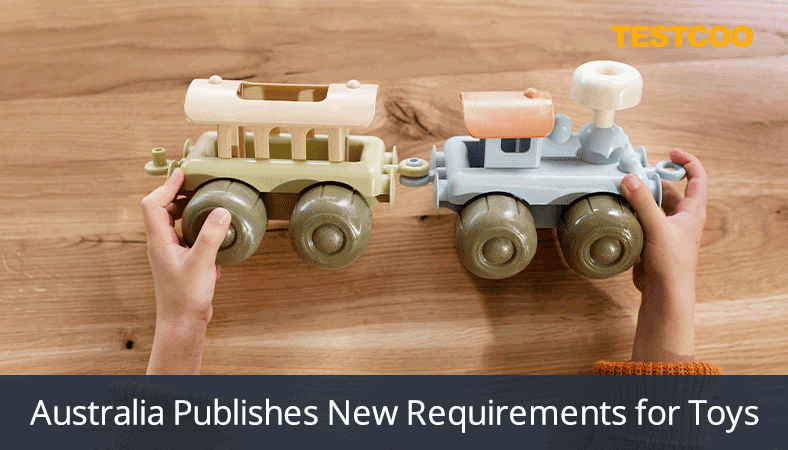Australia Publishes New Requirements for Toys

The Australian requirements for toys intended for children under three years of age have been amended with more stringent requirements for small parts to stop release during play or reasonable wear and tear. Australia has published more stringent requirements relating to small parts to help prevent choking, suffocation or death.
On 4 September 2023, the Australian Government published the new safety standard1 for children’s toys. The mandatory standard, the Consumer Goods (Toys for Children up to and including 36 Months of Age) Safety Standard 2023, sets out the requirements for toys for children up to and including 36 months of age. Suppliers have until 4 March 2025 to transition to the requirements of the new mandatory standard.
This safety standard prescribes requirements from the voluntary Australian and comparable overseas standards which seek to minimize the risk of young children choking or suffocating on small parts in toys and therefore preventing serious injury or death. The standard also places a new requirement on the battery compartments of toys.
The new requirements are found in?Consumer Goods (Toys for Children up to and including 36 Months of Age) Safety Standard 2023.
There is an 18 month transitional period until March 4, 2025. During this time, toys can comply with either the old 2005 or the new 2023 requirements. After March 4, 2025, only compliance with the 2023 requirements will be accepted.
The new 2023 requirements accept compliance to:
● Australian standard AS/NZS ISO 8124.1:2023 Safety of toys – Part 1: Safety aspects related to mechanical and physical properties
● Electric Toy Standard-Australian/New Zealand Standard AS/NZS 62115:2018-Electric toys—Safety
● International (ISO) standard ISO 8124 1:2022 Safety of toys – Part 1: Safety aspects related to mechanical and physical properties
● European (EN) standard EN 71 1:2014 + A1:2018: Safety of toys – Part 1: Mechanical and physical properties
● American (ASTM) standard ASTM F963 17 Standard Consumer Safety Specification for Toy Safety
The new 2023 requirements also include specific provisions relating to toys that contain batteries.
The mandatory standard requires any toy for a child aged up to and including 36 months, and containing any type of battery, to have the battery compartment secured in such a way that it can only be accessed by using a tool. This is based on the potential harm that can come from accessible batteries, as children up to 36 months of age can swallow small parts.
This means that for toys the battery requirements will become more stringent. The battery requirements that came into force in 2022 apply to button/coin batteries and products containing button/coin batteries, whereas the 2023 toy requirements apply to any type of battery.
More information is provided in battery regulation website.
Learn more about toys quality control in Toys Quality Control Inspection.
Free Sample Report Performance Quality Control
Download a sample report to keep control of your supply chain!
Featured Articles
 AQL Table | How to Read It
AQL Table | How to Read It TOP 10 Common Defects in Garments Quality Inspection
TOP 10 Common Defects in Garments Quality Inspection Product Packaging and Shipment Label requirements for Amazon FBA
Product Packaging and Shipment Label requirements for Amazon FBA What Is ASTM-F2413-18? Protective Footwear Standard
What Is ASTM-F2413-18? Protective Footwear Standard How to Conduct Third-Party Quality Control Inspections for Electric Scooters
How to Conduct Third-Party Quality Control Inspections for Electric Scooters SMETA Audit-What is SMETA Audit?
SMETA Audit-What is SMETA Audit? TESTCOO Supplier Verification/Certification Service SLCP, Higg FEM, GRS, GOTS
TESTCOO Supplier Verification/Certification Service SLCP, Higg FEM, GRS, GOTS Quality Control Inspection Company in China
Quality Control Inspection Company in China What is Quality Inspection? A Complete Guide
What is Quality Inspection? A Complete Guide Guidelines for Product Inspection in India
Guidelines for Product Inspection in India
Category
- Production Inspection Service
- Factory Audit
- Softline Inspection
- Hardline Inspection
- Electrics Inspection
- Certification
- Checklist
- Manufacturers
- Quality Assurance Basics
- Products Recall
- AQL
- Guidence and Standard
- News
- Supplier Management
- Amazon
- Protective Equipment
- e-commerce quality control
- Indian Manufacturing
- Soft Goods Quality Control
- Supply Chain Management
- Supply Chain Resilience
- E-Commerce Quality Control
- ISO 2859
- Supply Chain Optimization
- Garment Industry
- Higg Index



